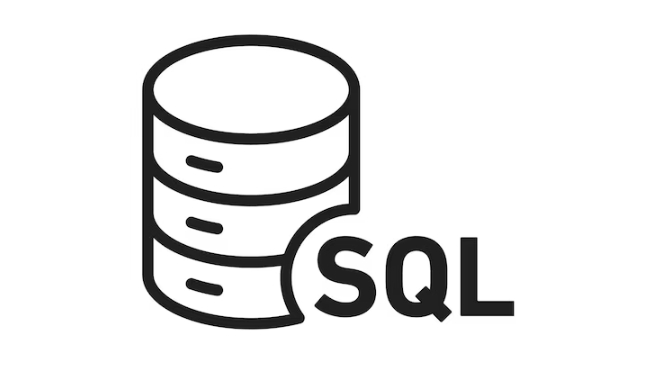Choosing appropriate data types for columns in a SQL database.
Jul 07, 2025 am 01:16 AMUnderstand the use of data types, such as INT for integers, DECIMAL for high-precision numerical values, VARCHAR for variable-length strings, and DATE/DATETIME for date and time. 2. Set length and accuracy according to the actual business to avoid wasting space or overflow errors. 3. Avoid implicit conversions affect performance, such as numbers should not be stored as strings. 4. Consider future expansion and database compatibility to ensure long-term maintenance convenience. Choosing the right data type requires taking into account current needs and future developments, which directly affects performance, storage and data integrity.

In SQL database design, choosing the right data type seems simple, but it actually directly affects performance, storage efficiency and data integrity. A common misunderstanding is "choose one that is sufficient", but in fact, each data type has its applicable scenarios.

1. Understand the uses of common data types
SQL supports a variety of data types, such as integers (INT), decimals (DECIMAL), strings (VARCHAR, CHAR), date and time (DATE, DATETIME), etc. Understanding the difference between them helps make a reasonable choice.

- Integer type : Applicable to values ??that do not require decimals, such as user ID, quantity, etc. The difference between TINYINT, SMALLINT, INT and BIGINT is the value range and storage space.
- Float and fixed-point numbers : FLOAT/DOUBLE is suitable for scientific calculations, but may have accuracy problems; while DECIMAL is more suitable for scenarios such as financial data that require high accuracy.
- String type : VARCHAR is suitable for text with large length variations, while CHAR is more suitable for content with fixed lengths, such as zip codes or country codes.
- Date and Time Type : DATE only saves dates, DATETIME and TIMESTAMP save date plus time, where TIMESTAMP also supports automatic updates and time zone conversion.
When selecting, consider the actual purpose of the field to avoid wasting storage space or causing overflow errors.
2. Set length and accuracy according to business requirements
Many developers prefer to use VARCHAR(255) or DECIMAL(18,2), but these "generic" settings are not always optimal.

- The string field should be determined based on the actual content length. For example, the email address generally does not exceed 100 characters, and there is no need to use 255.
- Numeric fields should take into account both precision and range. For example, if the amount field only involves RMB transactions, DECIMAL(10,2) is enough, and there is no need to use greater accuracy.
- Enumerated class information can be considered using ENUM type (supported by MySQL), or more flexible with TINYINT annotation description.
The advantage of this is to reduce unnecessary storage overhead and improve indexing efficiency.
3. Pay attention to the problems caused by implicit conversion
Sometimes, for convenience, numbers are stored in VARCHAR, and implicit type conversion is easily triggered during query or operation, affecting performance and even causing errors.
for example:
SELECT * FROM users WHERE id = '123';
If id is of INT type, although the result can be found, the database needs to convert the string to an integer first, which will add additional overhead and may also lead to the inability to use the index.
Similar ones:
- Store dates in strings, resulting in inaccurate sorting
- Use CHAR(1) to save the boolean value, but you can actually use TINYINT or BIT
This kind of practice looks fine in the short term, but it is easy to bury pits during long-term maintenance and expansion.
4. Consider future scalability and compatibility
Although a certain field now only needs to store numbers 0~255, if it may exceed this range in the future, don't use TINYINT, otherwise the later modification will be more expensive.
In addition, the support for data types varies slightly from different database systems. For example, PostgreSQL does not have a special BOOLEAN type but uses SMALLINT, and MySQL's ENUM may not be supported in other systems. This is especially important if you plan to do cross-platform migration or use ORM tools.
In general, choosing the right data type is not particularly complicated, but it does require a comprehensive judgment based on current needs and future development. Although the details are small, the impact is great.
The above is the detailed content of Choosing appropriate data types for columns in a SQL database.. For more information, please follow other related articles on the PHP Chinese website!

Hot AI Tools

Undress AI Tool
Undress images for free

Undresser.AI Undress
AI-powered app for creating realistic nude photos

AI Clothes Remover
Online AI tool for removing clothes from photos.

Clothoff.io
AI clothes remover

Video Face Swap
Swap faces in any video effortlessly with our completely free AI face swap tool!

Hot Article

Hot Tools

Notepad++7.3.1
Easy-to-use and free code editor

SublimeText3 Chinese version
Chinese version, very easy to use

Zend Studio 13.0.1
Powerful PHP integrated development environment

Dreamweaver CS6
Visual web development tools

SublimeText3 Mac version
God-level code editing software (SublimeText3)

Hot Topics
 OLTP vs OLAP: What Are the Key Differences and When to Use Which?
Jun 20, 2025 am 12:03 AM
OLTP vs OLAP: What Are the Key Differences and When to Use Which?
Jun 20, 2025 am 12:03 AM
OLTPisusedforreal-timetransactionprocessing,highconcurrency,anddataintegrity,whileOLAPisusedfordataanalysis,reporting,anddecision-making.1)UseOLTPforapplicationslikebankingsystems,e-commerceplatforms,andCRMsystemsthatrequirequickandaccuratetransactio
 How Do You Duplicate a Table's Structure But Not Its Contents?
Jun 19, 2025 am 12:12 AM
How Do You Duplicate a Table's Structure But Not Its Contents?
Jun 19, 2025 am 12:12 AM
Toduplicateatable'sstructurewithoutcopyingitscontentsinSQL,use"CREATETABLEnew_tableLIKEoriginal_table;"forMySQLandPostgreSQL,or"CREATETABLEnew_tableASSELECT*FROMoriginal_tableWHERE1=2;"forOracle.1)Manuallyaddforeignkeyconstraintsp
 What Are the Best Practices for Using Pattern Matching in SQL Queries?
Jun 21, 2025 am 12:17 AM
What Are the Best Practices for Using Pattern Matching in SQL Queries?
Jun 21, 2025 am 12:17 AM
To improve pattern matching techniques in SQL, the following best practices should be followed: 1. Avoid excessive use of wildcards, especially pre-wildcards, in LIKE or ILIKE, to improve query efficiency. 2. Use ILIKE to conduct case-insensitive searches to improve user experience, but pay attention to its performance impact. 3. Avoid using pattern matching when not needed, and give priority to using the = operator for exact matching. 4. Use regular expressions with caution, as they are powerful but may affect performance. 5. Consider indexes, schema specificity, testing and performance analysis, as well as alternative methods such as full-text search. These practices help to find a balance between flexibility and performance, optimizing SQL queries.
 How to use IF/ELSE logic in a SQL SELECT statement?
Jul 02, 2025 am 01:25 AM
How to use IF/ELSE logic in a SQL SELECT statement?
Jul 02, 2025 am 01:25 AM
IF/ELSE logic is mainly implemented in SQL's SELECT statements. 1. The CASEWHEN structure can return different values ??according to the conditions, such as marking Low/Medium/High according to the salary interval; 2. MySQL provides the IF() function for simple choice of two to judge, such as whether the mark meets the bonus qualification; 3. CASE can combine Boolean expressions to process multiple condition combinations, such as judging the "high-salary and young" employee category; overall, CASE is more flexible and suitable for complex logic, while IF is suitable for simplified writing.
 How to get the current date and time in SQL?
Jul 02, 2025 am 01:16 AM
How to get the current date and time in SQL?
Jul 02, 2025 am 01:16 AM
The method of obtaining the current date and time in SQL varies from database system. The common methods are as follows: 1. MySQL and MariaDB use NOW() or CURRENT_TIMESTAMP, which can be used to query, insert and set default values; 2. PostgreSQL uses NOW(), which can also use CURRENT_TIMESTAMP or type conversion to remove time zones; 3. SQLServer uses GETDATE() or SYSDATETIME(), which supports insert and default value settings; 4. Oracle uses SYSDATE or SYSTIMESTAMP, and pay attention to date format conversion. Mastering these functions allows you to flexibly process time correlations in different databases
 What is the purpose of the DISTINCT keyword in a SQL query?
Jul 02, 2025 am 01:25 AM
What is the purpose of the DISTINCT keyword in a SQL query?
Jul 02, 2025 am 01:25 AM
The DISTINCT keyword is used in SQL to remove duplicate rows in query results. Its core function is to ensure that each row of data returned is unique and is suitable for obtaining a list of unique values ??for a single column or multiple columns, such as department, status or name. When using it, please note that DISTINCT acts on the entire row rather than a single column, and when used in combination with multiple columns, it returns a unique combination of all columns. The basic syntax is SELECTDISTINCTcolumn_nameFROMtable_name, which can be applied to single column or multiple column queries. Pay attention to its performance impact when using it, especially on large data sets that require sorting or hashing operations. Common misunderstandings include the mistaken belief that DISTINCT is only used for single columns and abused in scenarios where there is no need to deduplicate D
 How to create a temporary table in SQL?
Jul 02, 2025 am 01:21 AM
How to create a temporary table in SQL?
Jul 02, 2025 am 01:21 AM
Create temporary tables in SQL for storing intermediate result sets. The basic method is to use the CREATETEMPORARYTABLE statement. There are differences in details in different database systems; 1. Basic syntax: Most databases use CREATETEMPORARYTABLEtemp_table (field definition), while SQLServer uses # to represent temporary tables; 2. Generate temporary tables from existing data: structures and data can be copied directly through CREATETEMPORARYTABLEAS or SELECTINTO; 3. Notes include the scope of action is limited to the current session, rename processing mechanism, performance overhead and behavior differences in transactions. At the same time, indexes can be added to temporary tables to optimize
 What is the difference between WHERE and HAVING clauses in SQL?
Jul 03, 2025 am 01:58 AM
What is the difference between WHERE and HAVING clauses in SQL?
Jul 03, 2025 am 01:58 AM
The main difference between WHERE and HAVING is the filtering timing: 1. WHERE filters rows before grouping, acting on the original data, and cannot use the aggregate function; 2. HAVING filters the results after grouping, and acting on the aggregated data, and can use the aggregate function. For example, when using WHERE to screen high-paying employees in the query, then group statistics, and then use HAVING to screen departments with an average salary of more than 60,000, the order of the two cannot be changed. WHERE always executes first to ensure that only rows that meet the conditions participate in the grouping, and HAVING further filters the final output based on the grouping results.






